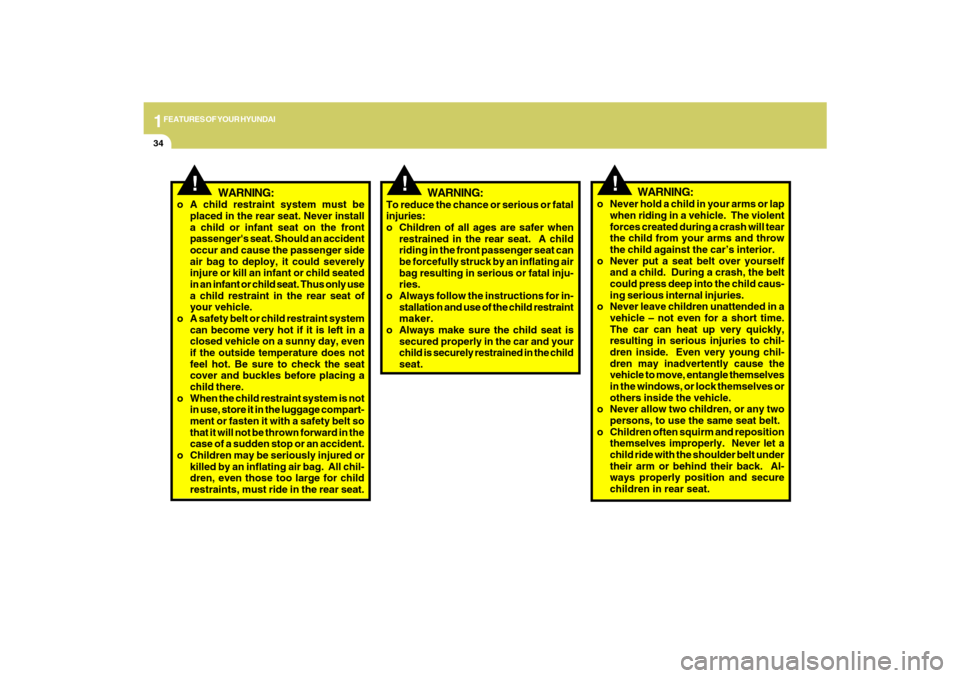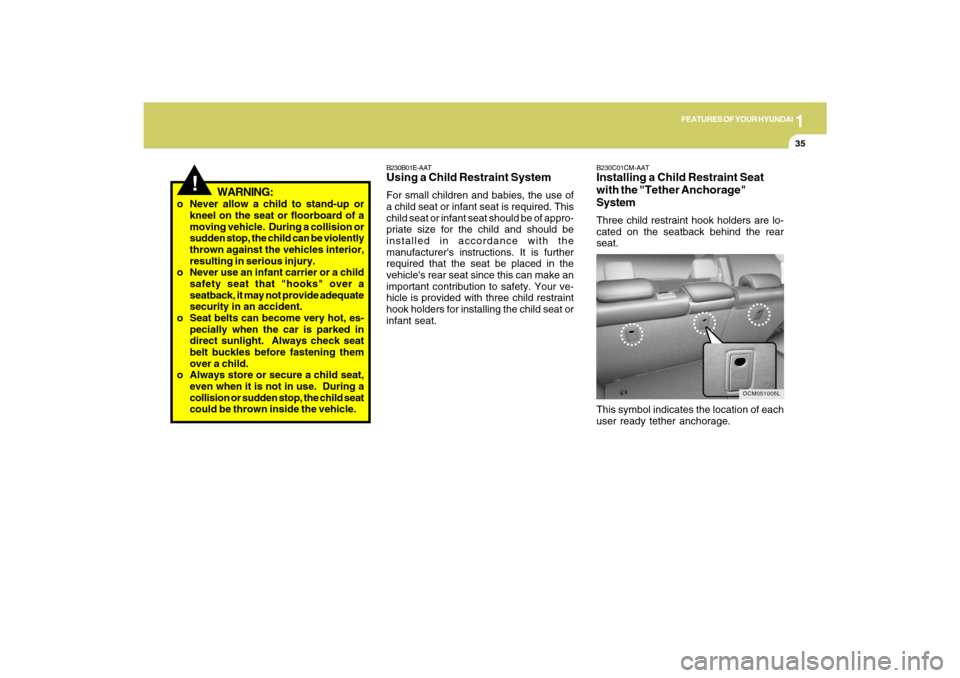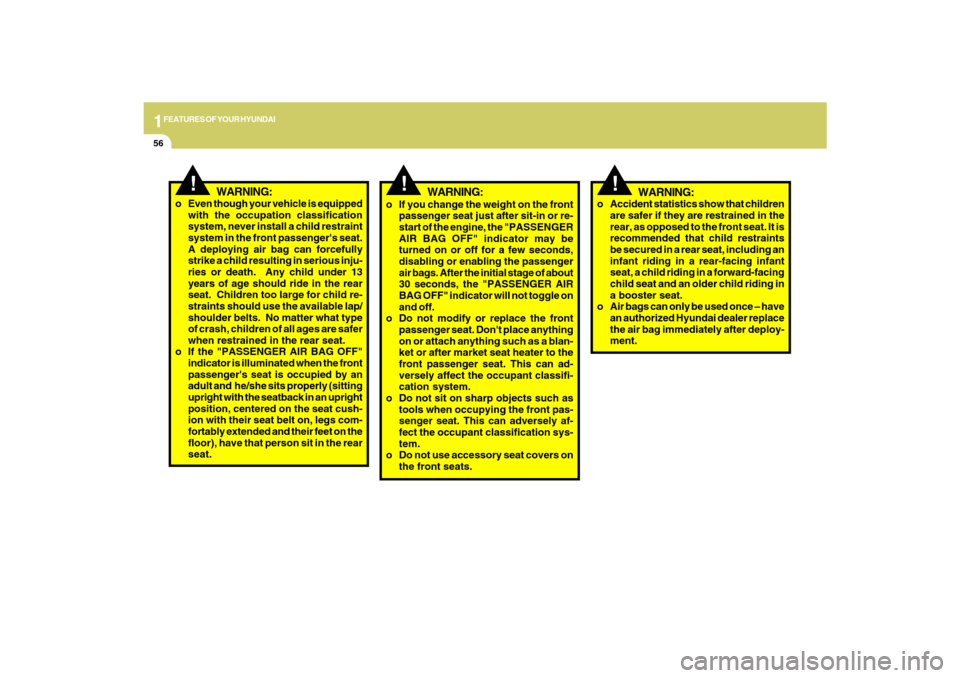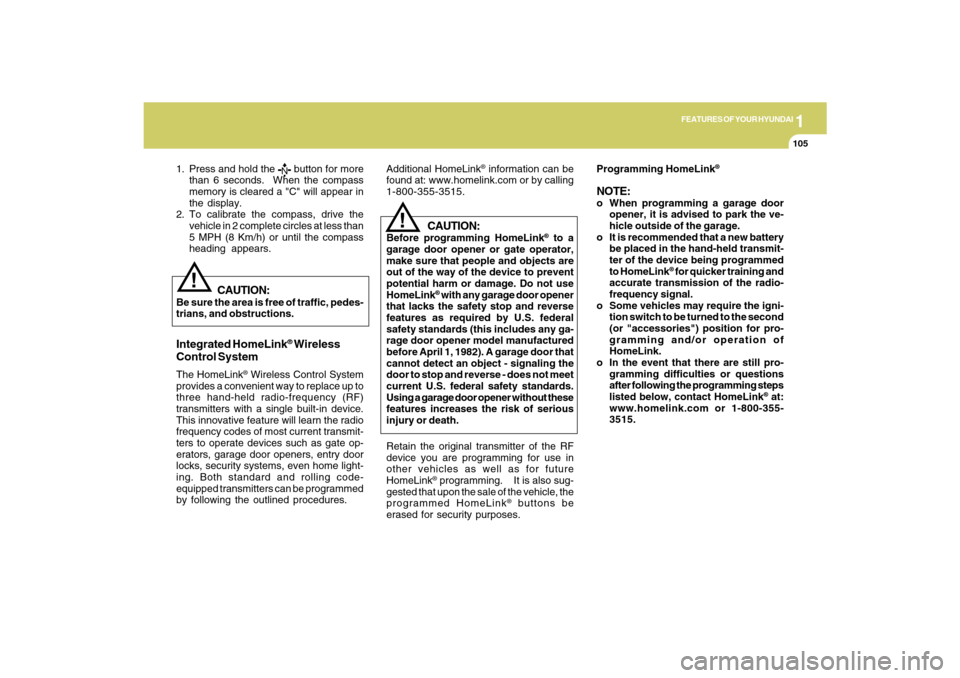2009 Hyundai Santa Fe ECU
[x] Cancel search: ECUPage 44 of 353

1
FEATURES OF YOUR HYUNDAI
33
WARNING:
You should place the lap belt portion as
low as possible and snugly across your
hips, not on your waist. If the lap belt is
located too high on your waist, it may
increase the chance of injury in the event
of a collision. Both arms should not be
under or over the belt. Rather, one should
be over and the other under, as shown in
the illustration. Never wear the seat belt
under the arm nearest the door.
!
B200A01A-AATAdjusting Your Seat Belt
B200A01NF
The seat belt is released by pressing the
release button in the locking buckle. When
it is released, the belt should automatically
draw back into the retractor.
If this does not happen, check the belt to be
sure it is not twisted, then try again.B210A01A-AATTo Release the Seat Belt
B210A01NF
CHILD RESTRAINT SYSTEMB230A01CM-AATChildren riding in the car should sit in the
rear seat and must always be properly
restrained to minimize the risk of injury in
an accident, sudden stop or sudden ma-
neuver. According to accident statistics
provided by the National Highway Traffic
Safety Administration (NHTSA), children
are safer when properly restrained in the
rear seats than in the front seat. Larger
children not in a child restraint should use
one of the seat belts provided.
All 50 states have child restraint laws. You
should be aware of the specific require-
ments in your state. Child and/or infant
safety seats must be properly placed and
installed in the rear seat. You must use a
commercially available child restraint sys-
tem that meets the requirements of the
Federal Motor Vehicle Safety Standards
(FMVSS). Child restraint systems are de-
signed to be secured in vehicle seats by
lap belts or the lap belt portion of a lap/
shoulder belt, or by a LATCH system (if
installed).
Children could be injured or killed in a
crash if their restraints are not properly
secured. For small children and babies, a
child seat or infant seat must be used.
Before buying a particular child restraint
system, make sure it fits your car seat and
seat belts, and fits your child. Follow all the
instructions provided by the manufacturer
when installing the child restraint system.
Page 45 of 353

1FEATURES OF YOUR HYUNDAI34
!
o Never hold a child in your arms or lap
when riding in a vehicle. The violent
forces created during a crash will tear
the child from your arms and throw
the child against the car’s interior.
o Never put a seat belt over yourself
and a child. During a crash, the belt
could press deep into the child caus-
ing serious internal injuries.
o Never leave children unattended in a
vehicle – not even for a short time.
The car can heat up very quickly,
resulting in serious injuries to chil-
dren inside. Even very young chil-
dren may inadvertently cause the
vehicle to move, entangle themselves
in the windows, or lock themselves or
others inside the vehicle.
o Never allow two children, or any two
persons, to use the same seat belt.
o Children often squirm and reposition
themselves improperly. Never let a
child ride with the shoulder belt under
their arm or behind their back. Al-
ways properly position and secure
children in rear seat.
WARNING:
!
WARNING:
To reduce the chance or serious or fatal
injuries:
o Children of all ages are safer when
restrained in the rear seat. A child
riding in the front passenger seat can
be forcefully struck by an inflating air
bag resulting in serious or fatal inju-
ries.
o Always follow the instructions for in-
stallation and use of the child restraint
maker.
o Always make sure the child seat is
secured properly in the car and your
child is securely restrained in the child
seat.
!
WARNING:
o A child restraint system must be
placed in the rear seat. Never install
a child or infant seat on the front
passenger's seat. Should an accident
occur and cause the passenger side
air bag to deploy, it could severely
injure or kill an infant or child seated
in an infant or child seat. Thus only use
a child restraint in the rear seat of
your vehicle.
o A safety belt or child restraint system
can become very hot if it is left in a
closed vehicle on a sunny day, even
if the outside temperature does not
feel hot. Be sure to check the seat
cover and buckles before placing a
child there.
o When the child restraint system is not
in use, store it in the luggage compart-
ment or fasten it with a safety belt so
that it will not be thrown forward in the
case of a sudden stop or an accident.
o Children may be seriously injured or
killed by an inflating air bag. All chil-
dren, even those too large for child
restraints, must ride in the rear seat.
Page 46 of 353

1
FEATURES OF YOUR HYUNDAI
35
!
WARNING:
o Never allow a child to stand-up or
kneel on the seat or floorboard of a
moving vehicle. During a collision or
sudden stop, the child can be violently
thrown against the vehicles interior,
resulting in serious injury.
o Never use an infant carrier or a child
safety seat that "hooks" over a
seatback, it may not provide adequate
security in an accident.
o Seat belts can become very hot, es-
pecially when the car is parked in
direct sunlight. Always check seat
belt buckles before fastening them
over a child.
o Always store or secure a child seat,
even when it is not in use. During a
collision or sudden stop, the child seat
could be thrown inside the vehicle.
B230C01CM-AATInstalling a Child Restraint Seat
with the "Tether Anchorage"
SystemThree child restraint hook holders are lo-
cated on the seatback behind the rear
seat.
This symbol indicates the location of each
user ready tether anchorage.
OCM051005L
B230B01E-AATUsing a Child Restraint SystemFor small children and babies, the use of
a child seat or infant seat is required. This
child seat or infant seat should be of appro-
priate size for the child and should be
installed in accordance with the
manufacturer's instructions. It is further
required that the seat be placed in the
vehicle's rear seat since this can make an
important contribution to safety. Your ve-
hicle is provided with three child restraint
hook holders for installing the child seat or
infant seat.
Page 47 of 353

1FEATURES OF YOUR HYUNDAI36
2. Route the child restraint seat tether strap
over the seatback. Seaback behind the rear seat
OCM052213L
Front of VehicleChild
restraint
hook
holders
!For vehicles with adjustable headrests,
route the tether strap under the head-
rest and between the headrest posts,
otherwise route the tether strap over the
top of the seatback.
3. Connect the tether strap hook to the
child restraint hook holder and tighten
to secure the seat.
WARNING:
o Adjust the rear seatback in a semi-
reclined position from the upright po-
sition, before installing the Child Re-
straint Seat. With the seatback in the
proper reclining angle, push and pull
the child restraint seat in different
directions to be sure it is secure.
o A child can be seriously injured or
killed in a collision if the child restraint
is not properly anchored. Always
follow the child seat manufacturer’s
instructions for installation and use.
o Never mount more than one child re-
straint to a single tether or to a single
lower anchorage point. The increased
load caused by multiple seats may
cause the tethers or anchorage points
to break, causing serious injury or
death.
Tether strap
hook
To install the child restraint seat
tether1. Open the tether anchor cover.
OCM051006L
Tether
anchor coverChild Restraint
Hook Holder
Page 48 of 353

1
FEATURES OF YOUR HYUNDAI
37
!
WARNING:
o A child can be seriously injured or
killed in a collision if the child restraint
is not properly anchored. Always
follow the child seat manufacturer’s
instructions for installation and use.
o Never install a child restraint using
the lower anchors at the center posi-
tion of the rear seat. In a crash, the
LATCH anchors may break if a car
seat is improperly placed in the cen-
ter position resulting in serious or
fatal injuries. Only place a LATCH or
LATCH-compatible child seat in the
left or right out-board rear seating
positions (as shown) to the appropri-
ate LATCH anchors provided.
B230D04CM-AATSecuring the Child Restraint Seat
with the "Child Seat Lower Anchor"
systemSome child seat manufacturers make safety
seats that are labeled as LATCH or LATCH-
compatible child seats. LATCH stands for
"Lower anchors and Tethers for Children".
These seats include two rigid or webbing
mounted attachments that connect to two
lower anchors at specific seating positions
in your vehicle. This type of child seat
eliminates the need to use seat belts to
attach the child seat; the tether strap must
also be attached to the proper tether an-
chor point. For information on using tether
straps, refer to “Installing a Child Restraint
Seat with the “Tether Anchorage” system”.
OCM051007L
LATCH anchors have been provided in
your vehicle. The LATCH anchors are lo-
cated in the left and right outboard 2nd rear
seating positions.
Their locations are shown in the illustra-
tion. There is no lower anchor provided for
the center rear seating position.
!
o Never mount more than one child re-
straint to a single tether or to a single
lower anchorage point. The increased
load caused by multiple seats may
cause the tethers or anchorage points
to break, causing serious injury or
death.
o When using the vehicle’s “LATCH”
system to install a child restraint sys-
tem in the rear seat, all unused ve-
hicle rear seat belt metal latch plates
or tabs must be latched securely in
their seat belt buckles and the seat
belt webbing must be retracted be-
hind the child restraint to prevent the
child from reaching and taking hold of
unretracted seat belts. Unlatched
metal latch plates or tabs may allow
the child to reach the unretracted seat
belts which may result in strangula-
tion and a serious injury or death to
the child in the child restraint.
WARNING:
Page 49 of 353

1FEATURES OF YOUR HYUNDAI38
!
WARNING:
o A child can be seriously injured or
killed in a collision if the child restraint
is not properly anchored to the car
and the child is not properly restrained
in the child restraint. Always follow
the child seat manufacturer’s instruc-
tions for installation and use.
o Adjust the rear seatback in a semi-
reclined position from the upright po-
sition, before installing the Child Re-
straint Seat. With the seatback in the
proper reclining angle, push and pull
the child restraint seat in different
directions to be sure it is secure. Child restraint symbols are located on the
left and right rear seat backs to indicate the
position of the lower anchors for child
restraints.Follow the child seat manufacturer's in-
structions to properly install safety seats
with LATCH or LATCH-compatible attach-
ments.
Once you have installed the LATCH child
restraint seat, assure that the seat is prop-
erly attached to the lower and tether an-
chors. Also, test the safety seat before you
place the child in it. Tilt the seat from side
to side. Also try to tug the seat forward.
Check to see if the anchors hold the seat
in place.
Lower AnchorPosition Indicator
Lower Anchor
OCM052306
B230D03CM
CAUTION:
Do not allow the rear seat belt webbing to
get scratched or pinched by the child-
seat latch and LATCH anchor during the
installation.
!
Page 67 of 353

1FEATURES OF YOUR HYUNDAI56
!
WARNING:
o Accident statistics show that children
are safer if they are restrained in the
rear, as opposed to the front seat. It is
recommended that child restraints
be secured in a rear seat, including an
infant riding in a rear-facing infant
seat, a child riding in a forward-facing
child seat and an older child riding in
a booster seat.
o Air bags can only be used once – have
an authorized Hyundai dealer replace
the air bag immediately after deploy-
ment.
!
WARNING:
o If you change the weight on the front
passenger seat just after sit-in or re-
start of the engine, the "PASSENGER
AIR BAG OFF" indicator may be
turned on or off for a few seconds,
disabling or enabling the passenger
air bags. After the initial stage of about
30 seconds, the "PASSENGER AIR
BAG OFF" indicator will not toggle on
and off.
o Do not modify or replace the front
passenger seat. Don't place anything
on or attach anything such as a blan-
ket or after market seat heater to the
front passenger seat. This can ad-
versely affect the occupant classifi-
cation system.
o Do not sit on sharp objects such as
tools when occupying the front pas-
senger seat. This can adversely af-
fect the occupant classification sys-
tem.
o Do not use accessory seat covers on
the front seats.
!
WARNING:
o Even though your vehicle is equipped
with the occupation classification
system, never install a child restraint
system in the front passenger's seat.
A deploying air bag can forcefully
strike a child resulting in serious inju-
ries or death. Any child under 13
years of age should ride in the rear
seat. Children too large for child re-
straints should use the available lap/
shoulder belts. No matter what type
of crash, children of all ages are safer
when restrained in the rear seat.
o If the "PASSENGER AIR BAG OFF"
indicator is illuminated when the front
passenger's seat is occupied by an
adult and he/she sits properly (sitting
upright with the seatback in an upright
position, centered on the seat cush-
ion with their seat belt on, legs com-
fortably extended and their feet on the
floor), have that person sit in the rear
seat.
Page 116 of 353

1
FEATURES OF YOUR HYUNDAI
105
1. Press and hold the
button for more
than 6 seconds. When the compass
memory is cleared a "C" will appear in
the display.
2. To calibrate the compass, drive the
vehicle in 2 complete circles at less than
5 MPH (8 Km/h) or until the compass
heading appears.
!
Integrated HomeLink
® Wireless
Control System
The HomeLink
® Wireless Control System
provides a convenient way to replace up to
three hand-held radio-frequency (RF)
transmitters with a single built-in device.
This innovative feature will learn the radio
frequency codes of most current transmit-
ters to operate devices such as gate op-
erators, garage door openers, entry door
locks, security systems, even home light-
ing. Both standard and rolling code-
equipped transmitters can be programmed
by following the outlined procedures.
CAUTION:
Before programming HomeLink
® to a
garage door opener or gate operator,
make sure that people and objects are
out of the way of the device to prevent
potential harm or damage. Do not use
HomeLink
® with any garage door opener
that lacks the safety stop and reverse
features as required by U.S. federal
safety standards (this includes any ga-
rage door opener model manufactured
before April 1, 1982). A garage door that
cannot detect an object - signaling the
door to stop and reverse - does not meet
current U.S. federal safety standards.
Using a garage door opener without these
features increases the risk of serious
injury or death.Programming HomeLink
®
NOTE:o When programming a garage door
opener, it is advised to park the ve-
hicle outside of the garage.
o It is recommended that a new battery
be placed in the hand-held transmit-
ter of the device being programmed
to HomeLink
® for quicker training and
accurate transmission of the radio-
frequency signal.
o Some vehicles may require the igni-
tion switch to be turned to the second
(or "accessories") position for pro-
gramming and/or operation of
HomeLink.
o In the event that there are still pro-
gramming difficulties or questions
after following the programming steps
listed below, contact HomeLink
® at:
www.homelink.com or 1-800-355-
3515.
Retain the original transmitter of the RF
device you are programming for use in
other vehicles as well as for future
HomeLink
® programming. It is also sug-
gested that upon the sale of the vehicle, the
programmed HomeLink
® buttons be
erased for security purposes.
CAUTION:
Be sure the area is free of traffic, pedes-
trians, and obstructions.
!
Additional HomeLink
® information can be
found at: www.homelink.com or by calling
1-800-355-3515.